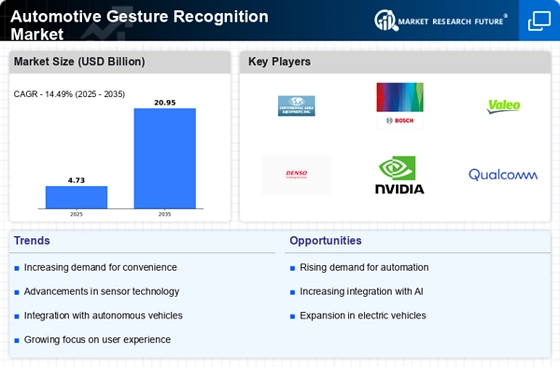Rising Demand for Enhanced User Experience
The Automotive Gesture Recognition Market is witnessing a notable increase in demand for enhanced user experiences within vehicles. As consumers become more accustomed to intuitive interfaces in their personal devices, they expect similar advancements in automotive technology. Gesture recognition systems allow drivers to control various functions, such as navigation and entertainment, with simple hand movements, thereby minimizing distractions. This trend is supported by data indicating that the market for gesture recognition in vehicles is projected to grow at a compound annual growth rate of approximately 20% over the next five years. Consequently, automotive manufacturers are increasingly investing in gesture recognition technologies to meet consumer expectations and improve overall satisfaction.
Integration with Smart Vehicle Technologies
The Automotive Gesture Recognition Market is being propelled by the integration of gesture recognition with smart vehicle technologies. As vehicles become increasingly connected, the ability to control various functions through gestures aligns with the broader trend of smart technology adoption. This integration allows for seamless interaction between the driver and the vehicle, enhancing the overall driving experience. Market analysts project that the convergence of gesture recognition with other smart technologies, such as voice recognition and artificial intelligence, will create a more cohesive user interface. This trend is likely to attract tech-savvy consumers who seek modern and efficient driving solutions.
Growing Interest in Autonomous Driving Solutions
The Automotive Gesture Recognition Market is also benefiting from the growing interest in autonomous driving solutions. As the automotive industry shifts towards automation, gesture recognition systems are being developed to facilitate interaction between the driver and the vehicle in semi-autonomous modes. These systems can provide drivers with the ability to issue commands or override automated functions through simple gestures, thereby enhancing user control and confidence. Market forecasts indicate that the demand for gesture recognition in autonomous vehicles could significantly increase, as manufacturers aim to create a more intuitive and user-friendly experience for drivers transitioning to automated driving.
Technological Advancements in Sensor Technologies
The Automotive Gesture Recognition Market is significantly influenced by rapid advancements in sensor technologies. Innovations in infrared, ultrasonic, and camera-based sensors have enhanced the accuracy and reliability of gesture recognition systems. These technologies enable vehicles to interpret a wide range of gestures, from simple swipes to complex commands, with high precision. As a result, the integration of these advanced sensors is expected to drive market growth, with estimates suggesting that the market could reach a valuation of several billion dollars by 2030. Furthermore, the continuous evolution of artificial intelligence and machine learning algorithms is likely to further refine gesture recognition capabilities, making them more appealing to automotive manufacturers.
Increasing Focus on Safety and Convenience Features
The Automotive Gesture Recognition Market is experiencing growth due to an increasing focus on safety and convenience features in vehicles. As regulatory bodies emphasize the importance of driver safety, manufacturers are integrating gesture recognition systems to reduce the need for physical interaction with controls. This shift not only enhances safety by allowing drivers to maintain their focus on the road but also adds a layer of convenience. Market data suggests that vehicles equipped with advanced gesture recognition systems are likely to see higher sales, as consumers prioritize safety features. This trend indicates a potential shift in consumer preferences towards vehicles that offer innovative safety technologies.

















Leave a Comment